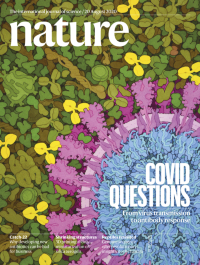Volume 584
-
No. 7822 27 August 2020
Under controlThe epithelium of glandular tissue such as mammary and prostate glands consists of adjacent layers of luminal and basal cells. During development, stem cells in the basal layer contribute to the formation of both cellular layers, but in adults, these stem cells lose their multipotency. This loss can be reversed when there is damage to the tissue, allowing the basal stem cells to contribute to the restoration of both layers. In this issue, Cédric Blanpain and his colleagues show that the potency of basal stem cells is directly regulated by luminal cells secreting TNF proteins, which act as an inhibitor of basal stem cell multipotency. The cover image shows a mammary gland branch with basal cells (red) and luminal cells (green).
Spotlight
-
No. 7821 20 August 2020
COVID questionsThe cover shows an artist’s impression of SARS-CoV-2 in the bloodstream based on the latest cryo-EM images of the virus, with neutralizing antibodies (yellow) attaching to the spike protein on the surface of the virus. This week’s issue features a number of papers at the cutting edge of research into the virus that causes COVID-19 — from transmission dynamics that could help control future outbreaks to antibody responses that may inform treatment strategies.
-
No. 7820 13 August 2020
Ground controlAs the climate warms it will destabilize organic matter in soils, causing an increase in the amount of carbon dioxide that they release into the atmosphere. For forests in temperate regions, four degrees of soil warming for two years increased CO2 emissions by around one-third, but tropical soils were expected to be less sensitive to warming. In this week’s issue, Andrew Nottingham and his colleagues present the results of a soil-warming experiment that challenge this assumption. The researchers conducted a warming experiment on lowland tropical forest soil on Barro Colorado Island in Panama (pictured on the cover). Two years of warming to raise the soil temperature by 4 °C resulted in an unexpectedly large increase in CO2 emissions of 55%. These results suggest that tropical soils are highly sensitive to warming and could present a substantial positive feedback to climate change.
-
No. 7819 6 August 2020
Jovian lightningThe cover shows an artist’s impression of small lightning flashes from high-altitude storms on Jupiter’s dark side. ‘Superbolt’ lightning from great depths has been observed on Jupiter before, but in this week’s issue, Heidi Becker and her colleagues present optical data from the Stellar Reference Unit camera onboard NASA’s Juno spacecraft that reveal flashes comparable in energy to standard lightning on Earth. The team identified flashes that lasted just 5.4 milliseconds with a time between flashes of tens of milliseconds. The observed flash rate is more than an order of magnitude greater than has been previously seen. The researchers note that several of the observed flashes occurred at altitudes where there is no liquid water. The observed ‘shallow lightning’ is explained by the existence of ammonia–water clouds that had not previously been recognized.
Focal Point




